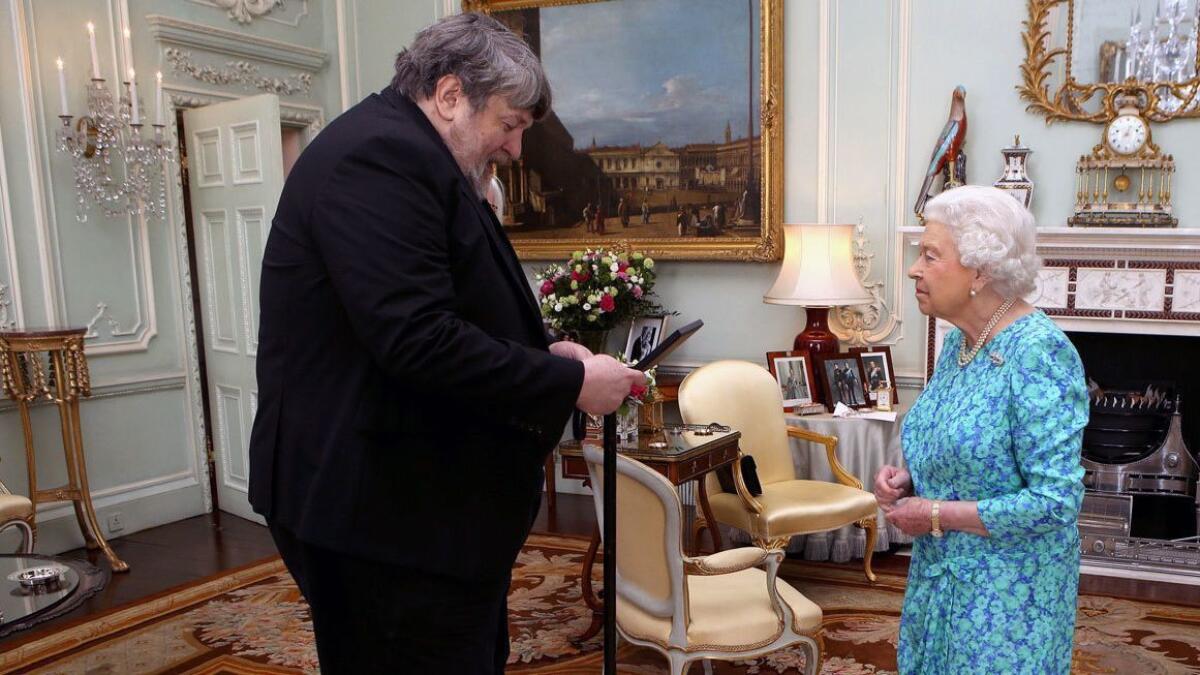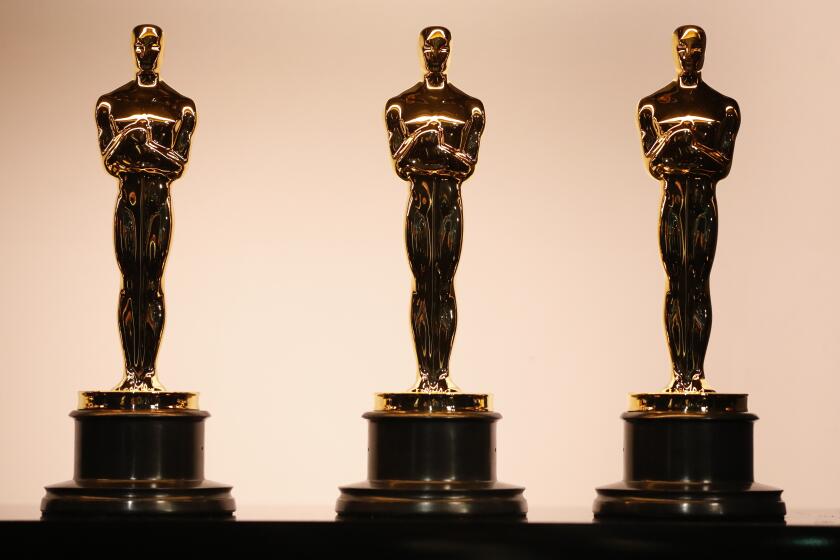As a conductor, composer and man, Oliver Knussen was larger than life

- Share via
British composer and conductor Oliver Knussen died Sunday at age 66, and since then, the tributes from those who knew and worked with him have flooded the British media. Reading their words, you might be led to believe that there was no finer composer in all of Britain. No more exacting conductor. No livelier musical mind. No more imaginative programmer. No more beloved mentor to young composers or better friend to older ones. No more generous musician or one with a more expansive heart.
I too knew Knussen. Nothing has been exaggerated.
Everything about Olly — he was Olly to all — was big. He was a giant in every way. Tall, heavy, lumbering, his massive frame filled the room. In the photograph from Buckingham Palace two years ago when he was handed the Queen’s Medal for Music, the monarch looks the size of a small child next to the composer. His appetite for food, wine, music, art, movies, people, conversation, laughter, literature and life was legendary.
But there were seeming contradictions. Disheveled in his dress, a collector whose house runneth over with books, recordings, movies, memorabilia and what not, he was also the most meticulous of musicians. As a composer, he was an obsessive perfectionist who in his last 20 years completed only six pieces, the longest of which, a violin concerto, is 17 minutes long. When he died, he had commissions galore in various unfinished states, including a cello concerto from the Los Angeles Philharmonic as well as pieces for the Cleveland Orchestra, the New York Philharmonic, the Philadelphia Orchestra and the Ojai Festival.
It wasn’t composer’s block exactly, although a hint of insecurity may have had deep roots under that well insulated, casual, Yoda-like exterior. Olly was a special case. His father, Stuart Knussen, was the principal double bass of the London Symphony and a powerful figure in the management of the self-governing orchestra. Young Olly grew up so surrounded by music and musicians that he said it never occurred to him that the world didn’t revolve around music.
An indifferent piano student who never had an ambition to be an instrumentalist, he wanted to write his own music from the moment he learned to read a score. He had early encouragement from Benjamin Britten, one of his father’s friends. He also had a natural talent for conducting. At age 16, he became a national sensation when he conducted his first symphony with the LSO.
The press called him a phenomenal prodigy, but Olly would have none of it, saying he merely started early. Self-critical from the start, he withdrew his symphony and decided he needed real study, much of which then occurred at Tanglewood, the Boston Symphony Orchestra’s summer home and teaching institution in the Berkshires. He was taken under the wing of the multi-faceted composer-conductor-jazz arranger Gunther Schuller. He caught the attention of Leonard Bernstein. He became friends with Michael Tilson Thomas.
He married an American French horn player who was a close collaborator on his musical projects. Later, after the couple separated in the 1990s (while remaining close and never divorcing), Sue Knussen was hired as education director of the L.A. Phil. Olly, who happened to be friends with Esa-Pekka Salonen, was also in the 1990s a regular guest conductor with the orchestra.
Beginning in 1983, Olly served for 15 years as co-director of the Aldeburgh Festival, which Britten had founded in Suffolk, England. Olly also headed the Tanglewood contemporary music program from 1986 to 1993, which I attended annually, discovering a vast range of music and meeting composers from all over the world. Students couldn’t get enough of their director, chanting at concerts, “Oooolly…Oooolly…Oooolly.”
From 1970 on, Knussen produced a steady stream of works until he began slowing down in the late ’90s. Many came last minute or late, and it could seem like pulling teeth to get them out; Sue regularly edited the scores through the night on the days before a premiere. But he wrote more music than he is usually given credit for. By the end of his life, Knussen had reached 50 works, and the variety is stunning.
His great passion was Modernist 20th century music. He was a rigorous abstract thinker who had to plan everything out mentally in complex detail before he could start writing. But the actual realization of his work always wound up dramatic, pictorial and full of strange contradictory currents that he found ingenious ways of making seem natural.
Quintessentially British as he was, he easily identified with American and Japanese music. He championed Aaron Copland, Morton Feldman and Elliott Carter. He was a close friend of Toru Takemitsu, Japan’s leading composer whose music he conducted more sensitively than anyone else — Asian, European, Scandinavian or American.
Indeed, Knussen’s first important piece, “Choral” for orchestra, written when he was 18, has elements of Charles Ives and Gagaku, ancient Japanese court music. His last major piece, which had its premiere last summer at Aldeburgh, was “O Hototogisu! — fragment of a Japonisme that Knussen had intended to turn into a full blown concerto for flute and soprano.
Among Knussen’s most durable scores have been his two very noncondescending yet highly entertaining children’s operas, “Where the Wild Things Are” and “Higglety Pigglety Pop!,” the concertos for horn and violin, a pair of symphonies and the startlingly moving “Requiem — Songs for Sue,” written in remembrance of his wife, who died in 2003.
Surveying Olly’s output, I am now struck by how death haunted is much of his work. He often chose dark texts to set. One favorite poet was Sylvia Plath. An early masterpiece is “Ophelia Dances” for orchestra from 1975. A late masterpiece is “Ophelia’s Last Dance,” written 35 years later for solo piano. Besides “Songs for Sue,” Knussen produced many extraordinary memorials; one that particularly stands out is the gong-like “Prayer Bell Sketch” for piano in memory of his Takemitsu.
The last time I saw Olly, in fact, was two years ago in Tokyo, where he conducted a special memorial on the 20th anniversary of Takemitsu’s death. It was a magical, transformative evening, Knussen getting a mid-level Japanese orchestra to project sounds as though they were a penetratingly shamanistic medium, music that went beyond music.
But Knussen’s last orchestral concert, at the Aldeburgh Festival last month, ended surprisingly with a Copland chestnut, “Appalachian Spring.” Surprisingly, that is, until one hears this one-of-a-kind valedictory performance (it can be streamed on the BBC Radio 3 website until July 20). There is an ethereal mysticism to the lyrical passages, and a big-hearted warmth. The textural clarity is so transparent that Knussen could be channeling Copland.
More startling still, but typical of Knussen, he unearthed a forgotten version of the score from 1951 that features some nasty bits of full ballet not included in the toned-down standard suite. This suggests an undercurrent that something may be terribly wrong. Here the famous “Gift to Be Simple” variations are interrupted by an angry outburst, although the ending is unforgettably ethereal.
And so it was. Three weeks later, Knussen’s very big heart gave out. We’ve lost a giant, one of the greats.
More to Read
Only good movies
Get the Indie Focus newsletter, Mark Olsen's weekly guide to the world of cinema.
You may occasionally receive promotional content from the Los Angeles Times.











